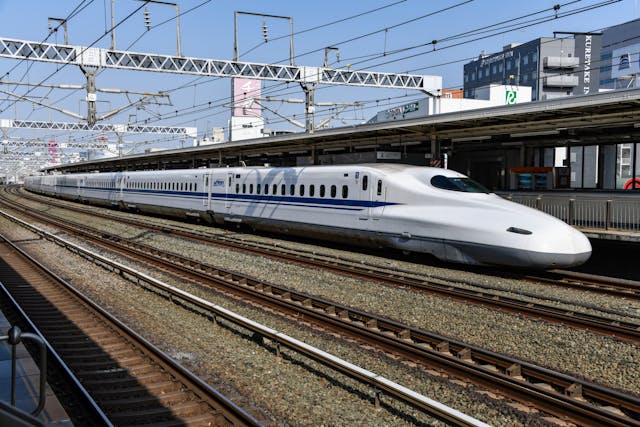At GertieBlu, we’re excited to explore a subject that’s transforming the way we think about travel—high-speed rail and bullet trains. These marvels of modern engineering are not only revolutionizing transportation but also shaping the future of how we connect cities and people. Let’s take a closer look at what makes high-speed rail so special, and discover five of the best-known bullet trains around the world.
What is High-Speed Rail?
High-speed rail refers to a type of passenger rail transport that operates significantly faster than traditional rail traffic. These trains often exceed speeds of 150 miles per hour (240 km/h), with some even breaking the 300 mph (483 km/h) barrier. The combination of cutting-edge technology, sleek designs, and efficient energy use makes high-speed rail a popular choice for sustainable and rapid travel.
Unlike airplanes, which require time-consuming check-ins and airport transfers, high-speed trains offer seamless, city-center-to-city-center connections. They also have a smaller environmental footprint, making them an attractive option in our quest for greener travel solutions.
The Benefits of High-Speed Rail
- Speed and Efficiency: Bullet trains dramatically reduce travel times between major cities. For example, a trip that might take six hours by car could take less than two hours on a high-speed train.
- Comfort and Convenience: These trains are designed with passenger comfort in mind, offering spacious seating, onboard dining, and the ability to move freely during the journey.
- Environmental Impact: High-speed trains emit significantly less CO2 per passenger compared to cars or airplanes, contributing to a reduction in greenhouse gas emissions.
- Economic Growth: By connecting cities more efficiently, high-speed rail can stimulate economic growth, encourage tourism, and create jobs.
- Safety: High-speed trains are among the safest modes of transportation, with advanced safety systems that make accidents exceedingly rare.

5 of the Best-Known Bullet Trains in the World
- Shinkansen (Japan): Japan’s Shinkansen, often known as the “bullet train,” is the pioneer of high-speed rail. Launched in 1964, it set the standard for what high-speed rail could achieve. The Shinkansen network connects major cities like Tokyo, Kyoto, and Osaka, reaching speeds of up to 200 mph (320 km/h). With an impeccable safety record and punctuality down to the second, the Shinkansen is a global icon of high-speed travel.
- TGV (France): France’s Train à Grande Vitesse (TGV) is another heavyweight in the high-speed rail arena. Debuting in 1981, the TGV connects Paris with cities like Lyon, Marseille, and Bordeaux at speeds of up to 186 mph (300 km/h). The TGV also holds the world speed record for conventional trains, reaching 357 mph (574.8 km/h) during a test run in 2007. Its sleek design and efficiency have made it a symbol of French engineering excellence.
- ICE (Germany): Germany’s Intercity-Express (ICE) is renowned for its comfort and reliability. The ICE network links major German cities such as Berlin, Munich, and Frankfurt, with extensions into neighboring countries. The trains typically travel at speeds of around 155 mph (250 km/h), but certain routes allow for speeds of up to 205 mph (330 km/h). The ICE trains are known for their luxurious interiors and smooth, quiet rides, making them a favorite among business travelers.
- Frecciarossa (Italy): Italy’s Frecciarossa, which means “Red Arrow,” is the flagship of the country’s high-speed rail service. Operated by Trenitalia, the Frecciarossa connects major cities like Milan, Rome, and Naples at speeds of up to 190 mph (300 km/h). With a focus on passenger experience, these trains offer several classes of service, including Executive Class, which features private meeting rooms and gourmet dining.
- CRH (China): China’s high-speed rail network, known as China Railway High-speed (CRH), is the largest in the world and continues to expand at an unprecedented rate. The CRH trains, particularly the CR400AF and CR400BF models (dubbed “Fuxing”), can reach speeds of up to 217 mph (350 km/h). Connecting cities like Beijing, Shanghai, and Guangzhou, the CRH network has transformed travel across China, making long-distance travel faster and more accessible to millions of people.

Final Thoughts
High-speed rail and bullet trains are more than just a fast way to get from point A to point B—they represent a shift toward more sustainable, efficient, and comfortable travel. Whether you’re zipping through the Japanese countryside on a Shinkansen or gliding across France on a TGV, these trains offer a glimpse into the future of transportation. As countries around the world continue to invest in high-speed rail, the possibilities for global travel are set to reach new heights.
Thanks for joining me on this journey into the world of bullet trains! Stay tuned to GertieBlu for more exciting insights into travel, technology, and the innovations shaping our world.
Until next time, GertieBlu









